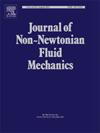Defying gravity: Injection of viscoplastic fluids in vertical channels
IF 2.8
2区 工程技术
Q2 MECHANICS
引用次数: 0
Abstract
We analyze the injection of a heavy viscoplastic fluid into a closed-end, two-dimensional vertical channel filled with a Newtonian fluid, focusing on flow dynamics across a wide range of density differences. Three distinct flow regimes are identified. At low density differences, the displacement flow below the injector is minimal. At high density differences, the injected fluid behaves like a free-falling jet, rapidly giving rise to advective instabilities near the advancing front. In the moderate density range, the injected fluid forms a finger-like interface and displaces the Newtonian fluid beneath the injector. Yet this flow also becomes unstable due to interfacial instabilities near the injection point. Surprisingly, we demonstrate that the heavy fluid ultimately flows upwards, regardless of the density difference. This counterintuitive behavior is attributed to the formation of a progressively more stable, density-stratified layer beneath the injector, which inhibits the downward movement of the heavy fluid. We further characterize the transient displacement flow at moderate density differences, where the front velocity initially becomes steady before re-accelerating at higher density differences. Our findings show that the front velocity is controlled by a balance between local density differences and viscous stresses, and we explain the mechanisms driving the re-acceleration at higher density differences. Remarkably, the interface shape remains consistent across all density differences.
抗重力:在垂直通道中注入粘塑性流体
我们分析了将重粘塑性流体注入一个充满牛顿流体的封闭的二维垂直通道中,重点研究了密度差范围内的流动动力学。确定了三种不同的流动形式。在低密度差时,喷油器下方的位移流量最小。在高密度差下,注入的流体表现得像自由落体的射流,在前进的锋面附近迅速引起平流不稳定。在中等密度范围内,注入的流体形成一个手指状界面,并取代注入器下方的牛顿流体。然而,由于注入点附近的界面不稳定,这种流动也变得不稳定。令人惊讶的是,我们证明,无论密度差如何,重流体最终都会向上流动。这种违反直觉的行为归因于注入器下方逐渐形成的更稳定的密度分层层,该层抑制了重质流体的向下运动。我们进一步描述了中等密度差下的瞬态位移流,其中锋面速度最初变得稳定,然后在较高密度差下重新加速。我们的研究结果表明,锋面速度是由局部密度差和粘性应力之间的平衡控制的,我们解释了在更高密度差下驱动再加速度的机制。值得注意的是,界面形状在所有密度差异中保持一致。
本文章由计算机程序翻译,如有差异,请以英文原文为准。
求助全文
约1分钟内获得全文
求助全文
来源期刊
CiteScore
5.00
自引率
19.40%
发文量
109
审稿时长
61 days
期刊介绍:
The Journal of Non-Newtonian Fluid Mechanics publishes research on flowing soft matter systems. Submissions in all areas of flowing complex fluids are welcomed, including polymer melts and solutions, suspensions, colloids, surfactant solutions, biological fluids, gels, liquid crystals and granular materials. Flow problems relevant to microfluidics, lab-on-a-chip, nanofluidics, biological flows, geophysical flows, industrial processes and other applications are of interest.
Subjects considered suitable for the journal include the following (not necessarily in order of importance):
Theoretical, computational and experimental studies of naturally or technologically relevant flow problems where the non-Newtonian nature of the fluid is important in determining the character of the flow. We seek in particular studies that lend mechanistic insight into flow behavior in complex fluids or highlight flow phenomena unique to complex fluids. Examples include
Instabilities, unsteady and turbulent or chaotic flow characteristics in non-Newtonian fluids,
Multiphase flows involving complex fluids,
Problems involving transport phenomena such as heat and mass transfer and mixing, to the extent that the non-Newtonian flow behavior is central to the transport phenomena,
Novel flow situations that suggest the need for further theoretical study,
Practical situations of flow that are in need of systematic theoretical and experimental research. Such issues and developments commonly arise, for example, in the polymer processing, petroleum, pharmaceutical, biomedical and consumer product industries.

 求助内容:
求助内容: 应助结果提醒方式:
应助结果提醒方式:


